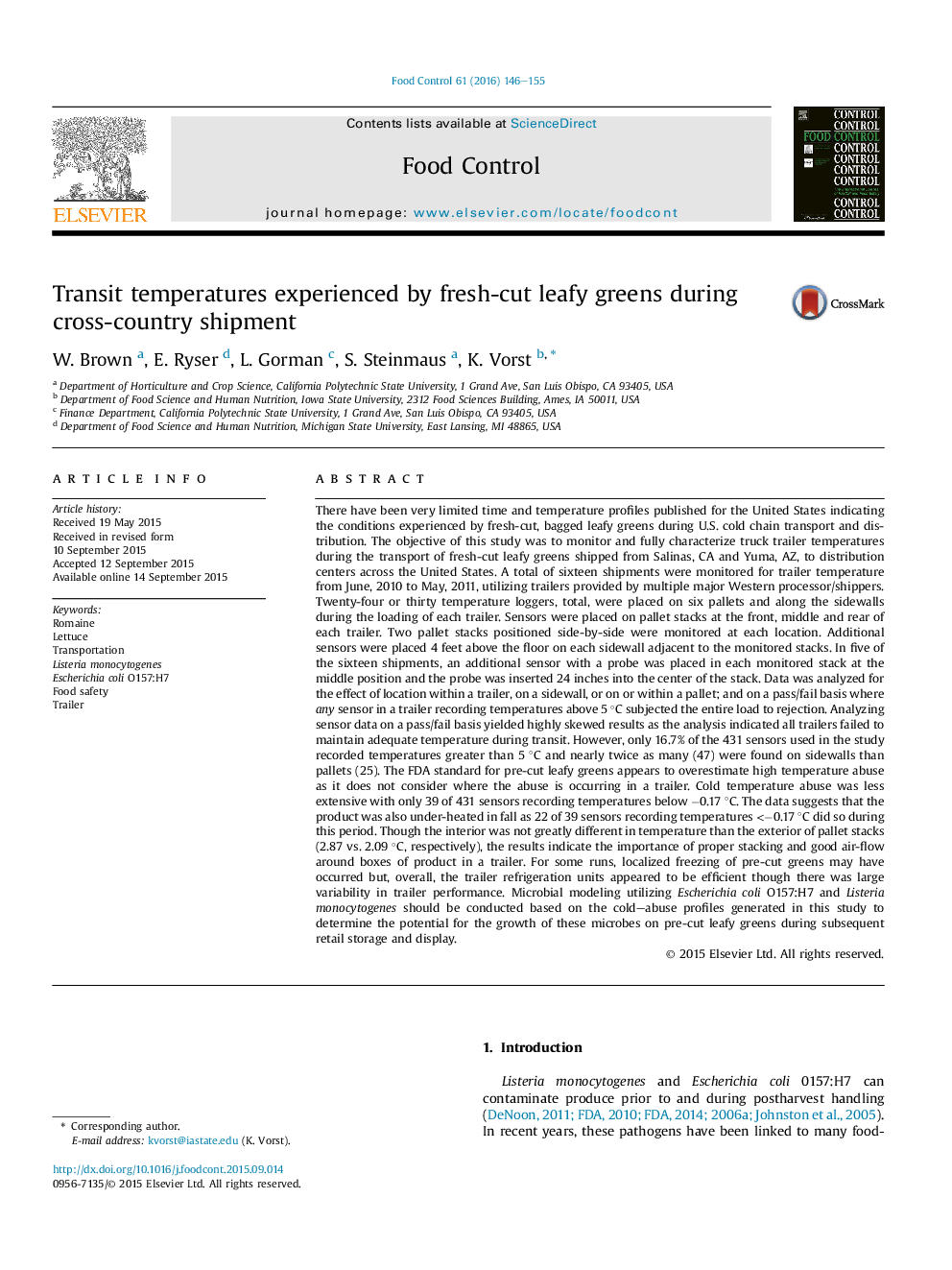| کد مقاله | کد نشریه | سال انتشار | مقاله انگلیسی | نسخه تمام متن |
|---|---|---|---|---|
| 4559112 | 1628401 | 2016 | 10 صفحه PDF | دانلود رایگان |
• Monitored truck trailer temperatures of fresh-cut bagged leafy greens.
• Truck temperature routes profiled throughout U.S in fall, winter, spring and summer.
• Temperature abuse overestimated during transit.
• Temperature greater than 5 °C on 16.7% of 431 sensors.
• Most temperature abuse occurs on sidewalls of truck trailer.
There have been very limited time and temperature profiles published for the United States indicating the conditions experienced by fresh-cut, bagged leafy greens during U.S. cold chain transport and distribution. The objective of this study was to monitor and fully characterize truck trailer temperatures during the transport of fresh-cut leafy greens shipped from Salinas, CA and Yuma, AZ, to distribution centers across the United States. A total of sixteen shipments were monitored for trailer temperature from June, 2010 to May, 2011, utilizing trailers provided by multiple major Western processor/shippers. Twenty-four or thirty temperature loggers, total, were placed on six pallets and along the sidewalls during the loading of each trailer. Sensors were placed on pallet stacks at the front, middle and rear of each trailer. Two pallet stacks positioned side-by-side were monitored at each location. Additional sensors were placed 4 feet above the floor on each sidewall adjacent to the monitored stacks. In five of the sixteen shipments, an additional sensor with a probe was placed in each monitored stack at the middle position and the probe was inserted 24 inches into the center of the stack. Data was analyzed for the effect of location within a trailer, on a sidewall, or on or within a pallet; and on a pass/fail basis where any sensor in a trailer recording temperatures above 5 °C subjected the entire load to rejection. Analyzing sensor data on a pass/fail basis yielded highly skewed results as the analysis indicated all trailers failed to maintain adequate temperature during transit. However, only 16.7% of the 431 sensors used in the study recorded temperatures greater than 5 °C and nearly twice as many (47) were found on sidewalls than pallets (25). The FDA standard for pre-cut leafy greens appears to overestimate high temperature abuse as it does not consider where the abuse is occurring in a trailer. Cold temperature abuse was less extensive with only 39 of 431 sensors recording temperatures below −0.17 °C. The data suggests that the product was also under-heated in fall as 22 of 39 sensors recording temperatures <−0.17 °C did so during this period. Though the interior was not greatly different in temperature than the exterior of pallet stacks (2.87 vs. 2.09 °C, respectively), the results indicate the importance of proper stacking and good air-flow around boxes of product in a trailer. For some runs, localized freezing of pre-cut greens may have occurred but, overall, the trailer refrigeration units appeared to be efficient though there was large variability in trailer performance. Microbial modeling utilizing Escherichia coli O157:H7 and Listeria monocytogenes should be conducted based on the cold–abuse profiles generated in this study to determine the potential for the growth of these microbes on pre-cut leafy greens during subsequent retail storage and display.
Journal: Food Control - Volume 61, March 2016, Pages 146–155
